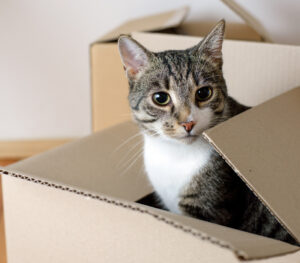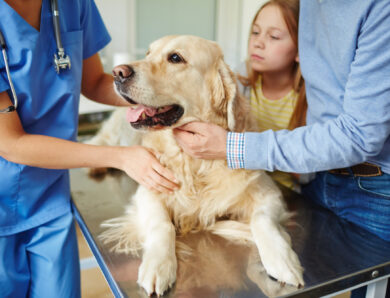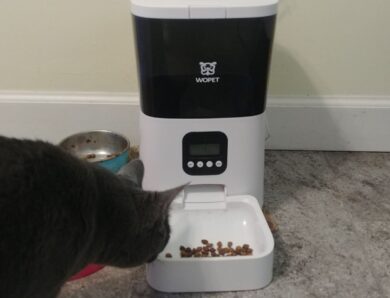There’s a reason no one likes moving. It’s Stressful with a capital S. Getting everything in order, stuff packed up, arrangements made, mail forwarded. The list of things that need to get done is daunting.
But we’re not the only ones feeling anxious. Our pets feel it too, a fact we often don’t think about.
“We don’t really think about how a move is going to emotionally affect them [pets] because we don’t think about our animals as having an emotional attachment [to our homes],” says Dawn Sampere-O’Grady, a real estate broker at Hallmark Realtors in Clark, New Jersey. “But they do, they’re attached to the yard, to what they hear and smell around the house.”
Sampere-O’Grady, who has experience moving with her own dogs, also works regularly with people moving home with pets of their own.
The anxiety our pets feel from all the commotion leading up to a move, as well as on the day of the move is compounded by the fact that they don’t understand what’s happening. This is especially true for pets that have grown up in their old homes. They’ve never known anything else. Add to that their ability to pick up on our heightened emotions, and moving can be a nightmare for many dogs and cats.
If you’re moving with pets, here are several things to keep in mind to make the experience as easy as possible.
Preparing for Moving with Pets
Gather Medical Records
If you’re moving far enough away that you’ll need a new vet, try to get as much of your pet’s medical records as you can. If possible, get paper copies, as well as a digital copy on a flash drive. Keep one of them with you when you move, just in case the other gets misplaced.
In particular, make sure you have a copy of your pet’s vaccinations, especially rabies, as the town or city you’re moving to may want to see proof — or your pet’s new vet might.
Information about any current medication your pet is on, including the brand and the dosage is also helpful to have.
Acclimate Pets to Carriers
While most dogs are familiar and comfortable with their crates, few cats are comfortable with their carriers. Even worse, most cats associate carriers with negative experiences, like going to the vet.
Since you’ll most likely be transporting your cat in a crate, you’ll want to get him used to it.
If your cat has negative associations with your current carrier, we suggest purchasing a new one. Leave it out for at least a week or two before the move. Put treats in it, along with her favorite toy. Or, if he has a beloved blanket or small bed that will fit in the carrier, put that in there as well.
As much as possible, you want the carrier to have only positive associations for your cats.
Microchips, Identity Tags & Photos

No one wants to think about worst-case scenarios. But, an ounce of prevention and all that.
If your pet isn’t already microchipped, get to the vet before the move to have a chip put in. If your pup or kitty is microchipped, make sure to update your contact info.
On moving day, your dogs and cats should be wearing a collar with an ID tag, even if they don’t normally. You want to be sure that if they should get lost that they can be immediately identified by anyone who finds them. Tag info should include your pet’s name, your name, your new address, and the best phone number for someone to reach you at.
Visit Your New Home
If you’re lucky enough to leave close by to your new home and you get the keys before the official move-in date, bring your pets over.
This is what Sampere-O’Grady did when she and her family moved with their two dogs, and what she recommends to all her clients who have pups.
And, while this is more feasible for dogs, you can do this with cats as well. You’ll just want to keep a close eye on them (or put a harness and leash on them) to make sure they don’t disappear during their exploration.
Give your pets a chance to walk around the new place. Let them get used to the layout. The more times you can do this the better, but not while the house is in chaos. If there are movers or painters or a plumber working in the house, the hubbub may be too much and the visit could do more harm than good.
Find out more about protecting your pets from house fires.
Prepare a Week One Kit
Anyone who’s ever moved knows that things get all mixed up, and can even go missing for days on end while you open up mislabeled boxes or search for a box that should have been right there.
To ensure you have everything you’ll need for your pet, we advise preparing a one-week kit, with enough food (and food/water bowls), kitty litter (and at least one litter box), toys, and grooming tools you’ll need to get through the first week in your new home. Keep this with you when you move.
Moving Time
Reserve a Safe Spot

Whether you’re moving everything out of your old place and into your new home in a single day or over the course of several days, things will be hectic. With movers coming in and out, familiar items packed up, furniture being lifted and shifted, the commotion will either terrify or over-excite your pet.
Your best bet is to keep your dog or cat away from the tumult. If you can, reserve a small bedroom for your pet. Keep his favorite bed and a few toys in there, and be sure to go in often to reassure him that all is okay.
Keeping your fur baby away from all the goings-on will prevent injuries (heavy boots and paws do not mix well!) and ensure your pet doesn’t run outside and away from all the noise and confusion.
Stick to Your Routine
No matter how hard you try, there’s no way to make a move seamless for your pet. But sticking to her normal routine can help. Dogs, and even cats, thrive on routine and familiarity; rather than boring, routine reassures them that their world is in order.
Keeping a routine in place during a move can go a long way in keeping your pet calm — or at least calmer.
If you normally walk your pup at certain times of the day, stick to those times as much as you can. If your pets are fed at a certain time, feed them at that time.
Sticking with your routine also means keeping things in the new house in the same place they were in your old home. This doesn’t have to be permanent, but at least for the first week or two, if your dog’s crate was in your bedroom in the old place, put it in the bedroom in the new place. Even if your new place is larger and you don’t need to have it there anymore.
Eventually, you can start moving the crate to where you want it to ultimately be, but if your pet is used to sleeping in the same room as you, the last thing he needs is to be moved away from you his first few nights in a strange place.
Forgot something during the move?
Keep ‘Em Close
While it’s not always possible, we highly recommend keeping your pet with you on moving day. Even if that means driving across several states instead of flying, it’s less stressful for your dog or cat if they can stay with you.
It’s bad enough that all that’s familiar to them is suddenly gone. That their favorite things aren’t where they’re supposed to be. If you’re not there too, they might think they’re being abandoned.
During stressful times, you are your pets’ security. By keeping them with you on moving day, your presence is a little bit of refuge they can take comfort in.
No Scolding
Moving is stressful. Period. Humans don’t like doing it, and neither do our pets, who don’t understand what’s happening. Stressed out, fearful, and confused, there’s a good chance your dog or cat may act out or make mistakes she doesn’t normally make — going to the bathroom outside her litter box for instance or chewing on something he normally wouldn’t.
Don’t scold them for accidents, of any kind. It isn’t intentional. It may take several days for your fur baby to settle down. During that time what they most need from you is extra love, not being yelled at, which will only prolong their heightened emotions.
Discover what trainers really think about scolding in 9 mistakes dog trainers say you’re making.
Extra Love

During the move, you’ll want to be aware of your pets’ emotional state of mind. In addition to the sudden change of scenery and, if applicable, longer-than-usual drive, they’re going to pick up on your excitement and anxiety and will respond accordingly, Sampere-O’Grady says.
You need to stay calm.
Keep an eye on your dog’s body language. Does he have his tail tucked between his legs? Is she visibly shaking?
Spend lots of time reassuring your pup that everything’s ok, that you still love them, that nothing’s wrong. While they won’t understand the words, they will understand the feeling behind them.
“You need to make sure that they know you’re not leaving them,” Sampere-O’Grady says. “In their world, you’re taking them someplace new and they’re not sure if you’re staying or leaving.”
The extra attention reassures them that you’re not going anywhere.
With that said — don’t go anywhere! At least not right away. In other words, don’t just drop your pet off at the new house and then go run an errand. That could potentially put your pet — especially a dog — into an insecure frenzy.
Treat cats the same way. Cats are exceptionally intuitive and they’ll pick up on the reassurance, even if they don’t act like it. You might also want to look into purchasing a calming ointment or spray. Treats and catnip can also offer stress release.
Carriers & Crates Are Best
We do recommend keeping your dog crated as much as possible during the drive, or at least any time someone is planning on opening a door. Because your dog might be anxious, he could be jumpier than usual and more likely to bolt as soon as a car or van door is opened. Keeping her in a crate ensures she can’t get loose in a strange place.
Keeping cats calm is more difficult. Few cats will be comfortable with a long (or short) drive. And, as much as you want to let them out of their carrier to provide reassurance, your kitty will probably feel safest inside.
Play!
Play is one of the best stress-busters that is. That’s true for humans and our paw-footed best friends. During the move try to take play breaks when you can. Whether that’s letting the dog out into the backyard to catch a ball or popping into the room you’re keeping your cats in to let them chase a laser pointer.
Find out more about the benefits of playing with your cats.
If your new home has a backyard, make that the first stop with your pup — before doing any unpacking.
If there’s time, Sampere-O’Grady says, place one or two of your dog’s favorite outdoor toys in the yard before you bring the dog in. This will give the yard a scent your dog is already familiar with making the new yard less scary, plus finding his own toys there will be reassuring.
Post Move
For One-Day Moves
If you’re moving into your new home the same day the movers arrive, you’ll want to provide the same type of seclusion you offered in your old home when the movers packed everything up.
Pick a “safe” room and set your dog or cat up inside until you’ve finished all the unpacking. Make sure it’s got everything your pet needs.
Regarding cats specifically, if your cat has been in the safe room for several days, he’ll be used to the new location of his litter box. As you open up the house to him, you’ll need to gradually move the litter box to whatever permanent spot you’ve chosen.
You can also put a second litter box in the permanent spot, while you move the original litter box closer over time. This way, they can learn the new spot but you also ensure that if they haven’t found it yet, they still know where to do their business.
For Multiple-Day Moves
If you have wiggle room for when you need to move into your new home, try to keep your pet away from the house until its fully furnished. This way you can give your pet the full tour, with her favorite things already in place. This will help her understand that this is her new home.
Whether you’re moving in a single day or over an extended period of time, once the house is furnished, you might still want to limit your pet’s access to all the rooms. Particularly if the home is much bigger than where you’ve come from, letting your pet get used to some of the rooms first can prevent him from feeling overwhelmed — or getting lost!
As your pet adjusts to the first few rooms, you can start opening doors to other areas.






